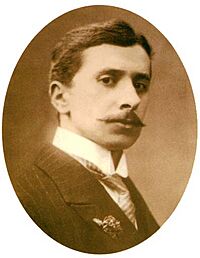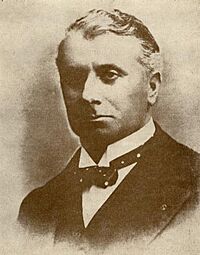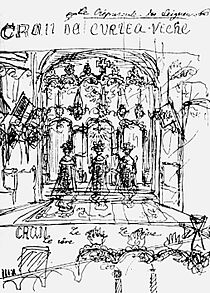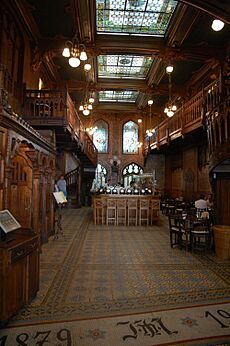Mateiu Caragiale facts for kids
Quick facts for kids
Mateiu Caragiale
|
|
|---|---|
 |
|
| Born | March 25, 1885 Bucharest, Romania |
| Died | January 17, 1936 (aged 50) Bucharest |
| Occupation | Poet, short story writer, novelist, visual artist, heraldist, civil servant, journalist |
| Period | 1912–1936 |
| Genre | lyric poetry, fantasy, satire, detective fiction, memoir |
| Literary movement | Symbolism, Decadence, Parnassianism, Modernism, Gândirea |
Mateiu Ion Caragiale (born March 25, 1885 – died January 17, 1936) was a Romanian poet and writer. He is most famous for his novel Craii de Curtea-Veche. This book tells the story of old noble families in Romania around the time of World War I.
Caragiale's writing style was unique for his time. It mixed ideas from Symbolism and early modernism. He also wrote some of the first detective fiction stories in Romania. Even though he didn't write many books, his work is highly praised. Many fans of his work are called mateists.
Besides writing, Mateiu Caragiale was also interested in heraldry (the study of coats of arms) and graphic art. He tried to work in politics and the civil service. He supported the Central Powers during World War I when they occupied Romania, which caused some debate. After the war, he focused more on writing. Most of his stories were published in the magazine Gândirea in the late 1920s and early 1930s.
Mateiu was the son of the famous playwright Ion Luca Caragiale. He was known for his unique style, being a bit of a dandy and enjoying a free-spirited life. He often spent time with other writers and thinkers at the Casa Capșa restaurant.
Contents
Biography
Early life and education
Mateiu Caragiale was born in Bucharest, Romania. His parents were Ion Luca Caragiale and Maria Constantinescu. He spent his early years at his mother's house. Later, his father married Alexandrina Burelly, and Mateiu joined their new family. He often disagreed with his father.
He went to school at Sfântul Gheorghe College in Bucharest. There, he became very interested in history and heraldry. He also met important people like the writer Barbu Ștefănescu-Delavrancea. In 1903, he traveled through Western Europe with his father's family. He visited places like Austria-Hungary, Switzerland, Italy, and France. He learned a lot about European art during this trip.
In 1904, his father moved to Berlin and wanted Mateiu to study law there. But Mateiu preferred to read and explore the city. He called this time "the vagrant school" because he learned so much on his own. He loved visiting the Tiergarten park and the National Gallery. He especially liked paintings by Jacob Isaakszoon van Ruisdael. His father was not happy with this. So, in 1905, Mateiu was sent back to Romania. He briefly studied law at the University of Bucharest but quit after a year.
First writings and family life

Mateiu's relationship with his father was often difficult. His father stopped giving him money, which made things hard for Mateiu and his mother. Mateiu then joined a literary group led by Alexandru Bogdan-Pitești, who helped him financially.
In 1907, Mateiu visited his father's family in Berlin again. He was also very interested in the rumors about the 1907 Romanian Peasants' Revolt, seeing it as an exciting event. He tried to study at the university again in 1909 but did not finish.
Mateiu started thinking about his famous novel, Craii de Curtea-Veche, in 1910. Two years later, he published his first 13 poems in the magazine Viața Românească. Some critics praised his work, while others made fun of it. His father, Ion Luca Caragiale, actually helped him get these poems published and admired them.
His father died in June 1912. Mateiu seemed unaffected by this, even making a cold comment at the funeral.
Working for the government
After his father's death, Mateiu returned to Bucharest. In 1912, he got a job at a French newspaper. Soon after, he became a chief of staff in the Ministry of Public Works. He had shown some interest in politics before, seeing it as a way to get ahead. He got this job with the help of Alexandru Bădărău, a minister.
Mateiu started his government job on November 7, 1912. He later said that the official records were changed to make it seem like he started earlier. During his time in office, he was involved in talks with Serbia about building a bridge over the Danube river. In 1913, he received several honors, including being made a Knight of the Romanian Order of the Crown. He also got medals from the Russian Empire and Romania.
In 1913, Caragiale wrote the story Remember. His job ended on January 17, 1914, when a new government took power. He felt that his small role in politics had made him a target.
World War I and later life
During the early part of World War I, Romania was neutral. Mateiu's friend, Bogdan-Pitești, was working for the Central Powers. Mateiu himself had some sympathy for the German side. He often visited the Casa Capșa restaurant, where he met with friends. He also worked briefly as a press correspondent for an Ottoman news agency.
When Romania joined the Allied Powers in 1916, Mateiu stayed in Bucharest. He started writing the first part of Craii de Curtea-Veche. He saw 1916 as the end of an old way of life. He supported the pro-German side during the occupation. This political choice was very controversial and later ended his political career.
In 1919, he became head of the press office for the Minister of Internal Affairs. He was not happy with this job and resigned in 1921. He was living in poverty for a while, struggling to pay rent. Writing Craii... helped him cope with his situation.
In 1921, his story Remember was published. He wrote the second part of Craii... between 1918 and 1921, often in unusual places like restaurants or gambling dens. In 1923, he married Marica Sion, who was 25 years older than him. She was the daughter of a nobleman, and through her, he gained a property in Fundulea.
Craii de Curtea-Veche and travels
Mateiu Caragiale published Remember as a book in 1924. From 1922, he started working on the third and final part of Craii.... Some of his poems were included in a 1925 collection. He also planned to publish a series of poems called Pajere, which came out after his death.
His novel Craii de Curtea-Veche was published in parts in Gândirea magazine from March 1926 to October 1928. He finished the last parts of the book in November 1927. When the final part was published, it received great praise. He felt proud of the work, calling it "truly magnificent."
In 1926, he tried to get a seat in Parliament but was not successful. In 1928, he tried to get a job at the Romanian Consulate in Helsinki, Finland. He visited Nicolae Titulescu, the Foreign Minister, in Italy to discuss this. The talks didn't lead to a job, but Mateiu was very impressed by the Italian scenery. He even tried to create an "Italian rustic quietude" at his property in Fundulea.
His political plans were put on hold. Instead, he focused on getting the French Légion d'honneur award. He became a Knight of this order in December 1929, with the help of a friend from a French newspaper.
Later years and death
Caragiale also started writing two other works: Soborul țațelor ("The Council of Busibodies", 1929) and the detective story Sub pecetea tainei ("Under the Seal of Secrecy", 1930). Both remained unfinished. Sub pecetea tainei was published in parts in Gândirea.
In 1931, he still hoped to return to politics. He asked for a job as a prefect but was refused. He also attended cultural events, like a banquet for Italian author Filippo Tommaso Marinetti in 1930. In 1934, he signed a contract to finish and publish Sub pecetea tainei.
He stopped most literary activities later that year. He wrote in his diary that he felt like people nearing their end. He was planning to move to Fundulea and cut ties with his friends. However, he did not completely stop writing. In 1931, a magazine published his memoir called Vechi impresii de spectator ("Old Impressions of a Spectator"). He wrote that he had reached "a serene maturity" and was starting "a new life." He was also interested in writing a biography of an 18th-century nobleman. He thought a lot about death, which he feared.
Mateiu Caragiale died two years later in Bucharest, at age 51, after having a stroke.
Interests and personal life
Mateiu Caragiale loved heraldry (coats of arms) and genealogy (family history). This showed his interest in history and his unique view of the world. He started drawing coats of arms in college. He was also curious about astronomy, magic, botany, and farming. He even kept detailed notes about the deaths of Romanian noble families.
Because of these interests and his ability to talk well, he was seen as a very knowledgeable person, even without a formal degree. He was always seeking beauty and perfection. The poet Ion Barbu said that Caragiale would visit the Romanian Academy just to look at a math page about the "rule of three." He found its "splendor" inspiring. Caragiale was also drawn to esotericism, alchemy, and mystical subjects like numerology. These ideas often appeared in his stories.
A big part of Mateiu Caragiale's life was his search for noble family roots. He wanted to find a connection to old noble families. He even joked about being a "Prince Bassaraba-Apaffy," mixing names of old noble lines. He also claimed that his mother was from Austria-Hungary and that he was born in Tușnad, Transylvania. He even tried to use marriage to improve his wealth and status.
Between 1907 and 1911, Caragiale studied Romanian heraldry. He read a book called Familii boierești române ("Romanian Boyar Families"). He filled his copy with sarcastic comments and drawings of boyars and caricatures. He also created heraldic symbols for himself. In 1928, he even raised a flag he designed for the Caragiale family at his property. He also flew the flag of Hungary, claiming it showed his foreign background.
Other unique habits included wearing a special "princely gown" he designed. He also had unusual ways of speaking and loved official decorations. He was very proud of the medals he received from the Romanian government. He regretted not getting Finland's Order of the White Rose. Some believe he sought these honors to make up for his uncertain family background.
Legacy
Early influence and Mateism
Mateiu Caragiale remained an important writer for many years after his death. His poems Pajere were published in 1936. Later that year, a collection of his works, Opere, was also released. Sadly, many of his personal diaries and drawings have been lost over time.
His work quickly gained influence. The poet Ion Barbu created the terms mateist (for his supporters) and matein (for things related to his literature). Barbu even started the first mateist club. Other writers were inspired by his style.
His work during communism
The mateism movement continued even during the communist regime. It became a kind of underground cultural trend. Some writers, like Tașcu Gheorghiu, knew large parts of Craii... by heart. Caragiale's unique style was very different from the official "Socialist Realism" promoted by the government in the 1950s.
However, after Joseph Stalin's death, things changed a bit. Some writers tried to bring Caragiale's work back into the public eye. But the government's censorship still made it difficult. Students at the University of Bucharest would even try to find the real locations of houses described in Craii....
In the 1960s, with some liberalization, Caragiale's work became more accepted. Nicolae Ceaușescu's rise led to a focus on Romanian culture. Critics like Edgar Papu even claimed Caragiale was ahead of his time. New generations of writers rediscovered him. Some wrote sequels to his unfinished stories, and others were inspired by his novels and poems.
Later, in the 1980s, a group of writers called Optzeciști (Eighty-ers) also found inspiration in Caragiale's work. They used fantasy and avant-garde ideas to get around cultural rules. Many of them, like Mircea Cărtărescu, saw Caragiale as an important writer from the past. More books and studies about Caragiale were published during this time.
After 1989 and modern views
After the Romanian Revolution of 1989, Caragiale's work became fully accepted in mainstream culture. In 2001, Craii de Curtea-Veche was voted the "best Romanian novel of the twentieth century" in a poll. Mateiu Caragiale is still one of the most studied Romanian writers.
Many new books and studies have been written about him. Some critics, like Barbu Cioculescu, are strong supporters of his work. Matei Călinescu compared Craii... to a special place that contains all other places, showing its richness. Nicolae Manolescu also considers Caragiale one of the most important writers of his generation.
However, not everyone agrees. Some critics, like Mircea Mihăieș, believe that Craii... is not well-written and is too simple or even "kitsch." They think his poems and letters are more valuable.
In 2001, Caragiale's collected writings were republished. His copy of the book Familii boierești române, with his notes and drawings, was also reprinted in 2002. Other memoirs from his friends also mention him.
After the Revolution, writers continued to be inspired by Caragiale. In 2008, Ion Iovan wrote a fictional diary about Caragiale's last days. Writers in Moldova also found inspiration in his work.
Visual art, films, and landmarks
Marcel Janco created modernist portraits of Caragiale in 1925. Later, the book Craii de Curtea-Veche was illustrated by George Tomaziu.
The novel Craii... has been adapted for the stage and screen. The Nottara Theater performed a stage version. Another play used parts of his novel. In 2009, his story Remember was turned into a musical theater and contemporary ballet show.
In the early 1970s, Mateiu Caragiale's life was the subject of a Romanian Television production. In 1995, Craii... was made into a movie directed by Mircea Veroiu. The book and its author were also featured in a documentary series about Bucharest in 2007.
A street in Bucharest is named after Mateiu Caragiale. It used to be called "Constitution Street."





